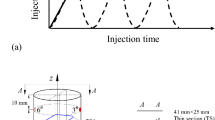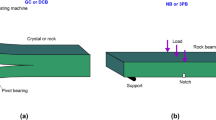Abstract
An experimental and computational study was conducted to evaluate the dynamic response of weathered biaxial composite plates subjected to near-field explosive/blast loadings. Naval structures are subjected to aggressive marine environments during their service life that can significantly degrade their performance over time. The composite materials in this study are carbon–epoxy composite plates with [0, 90]s and [45, − 45]s layups. The composites were aged rapidly through submersion in 65 \(^{\circ }\)C seawater for 35 and 70 days, which through Arrhenius’ methodology, simulates approximately 10 and 20 years of operating conditions, respectively. Experiments were performed by clamping the composite plates to an air-backed enclosure inside an underwater blast facility. During the experiments, an RP-503 explosive was submerged, behind the composite specimen, and detonated. Meanwhile, transducers measured the pressure emitted by the explosive, and three high-speed cameras captured the event. Two of the cameras were placed facing the specimen to measure full field displacement, velocities, and strains through a 3D digital image correlation analysis. The third high-speed camera was used to record the explosive’s behavior and bubble-to-specimen interaction. Additional experiments were performed to obtain the non-weathered and weathered material properties as well as the residual strength post the blast experiments. Additionally, a coupled Eulerian–Lagrangian finite element simulation was conducted to complement the experimental findings. Results show that the diffusion of water into the composite material leads to a more prominent blast response as well as the degradation of mechanical properties, especially shear properties which are dominated by the epoxy matrix. Residual strength experiments also show a substantial decrease in the structural integrity post-blast loading for the weathered composites. Lastly, the numerical simulations showed substantial increase in maximum strains with relatively small decreases in mechanical stiffness. Hence, even past the saturation point, incremental changes in material properties can have a significant impact on mechanical performance.











Similar content being viewed by others
References
Amer M, Koczak M, Schadler L (1996) Relating hydrothermal degradation in single fiber composites to degradation behavior in bulk composites. Compos A Appl Sci Manuf 27(9):861–867. https://doi.org/10.1016/1359-835x(96)00049-8
ASTM Standard D1141-98 (2013) Standard practice for the preparation of substitute ocean water. ASTM International, West Conshohocken. https://doi.org/10.1520/D1141-98R13
ASTM Standard D2734-16 (2016) Standard test methods for void content of reinforced plastics. ASTM International, West Conshohocken. https://doi.org/10.1520/D2734-16
ASTM Standard D3039-14 (2014) Standard test method for tensile properties of polymer matrix composite materials. ASTM International, West Conshohocken. https://doi.org/10.1520/D3039_D3039M-14
ASTM Standard D3518-13 (2013) Standard test method for in-plane shear response of polymer matrix composite materials by tensile test of a \(\pm \)45\(^{\circ }\) laminate. ASTM International, West Conshohocken. https://doi.org/10.1520/D3518_D3518M
ASTM Standard D5229-14 (2014) Standard test method for moisture absorption properties and equilibrium conditioning of polymer matrix composite materials. ASTM International, West Conshohocken. https://doi.org/10.1520/D5229_D5229M-14
ASTM Standard D7137-12 (2012) Standard test method for compressive residual strength properties of damaged polymer matrix composite plates. ASTM International, West Conshohocken. https://doi.org/10.1520/D7137_D7137M-12
Batra R, Hassan N (2007) Response of fiber reinforced composites to underwater explosive loads. Compos B Eng 38(4):448–468. https://doi.org/10.1016/j.compositesb.2006.09.001
Blikstad M, Sjoblom PO, Johannesson TR (1984) Long-term moisture absorption in graphite/epoxy angle-ply laminates. J Compos Mater 18(1):32–46. https://doi.org/10.1177/002199838401800103
Browning C, Husman G, Whitney J (1977) Moisture effects in epoxy matrix composites. In: Davis J (ed) Composite materials: testing and design (fourth conference), STP26961S. ASTM International, West Conshohocken, PA, pp 481–496. https://doi.org/10.1520/STP26961S
Choqueuse D, Davies P (2008) Aging of composites in underwater applications. Aging Compos. https://doi.org/10.1201/9781439832493.ch18
Choqueuse D, Davies P, Mazéas F, Baizeau R (1997) Aging of composites in water: comparison of five materials in terms of absorption kinetics and evolution of mechanical properties. In: High temperature and environmental effects on polymeric composites, vol 2. https://doi.org/10.1520/stp11369s
Crank J (1975) The mathematics of diffusion, 2nd edn. Oxford University Press, Oxford
Davies P (2016) Environmental degradation of composites for marine structures: new materials and new applications. Philos Trans R Soc A Math Phys Eng Sci 374(2071):20150272. https://doi.org/10.1098/rsta.2015.0272
Davies P, Rajapakse Y (2014) Durability of composites in a marine environment. Springer, Dordrecht
Deiasi RJ, Whiteside JB, Wolter W (1980) Effects of varying hygrothermal environments on moisture absorption in epoxy composites. In: Fibrous composites in structural design. pp 809–818. https://doi.org/10.1007/978-1-4684-1033-4_48
Dobratz B (1972) Properties of chemical explosives and explosive simulants. Lawrence Livermore National Laboratory, Livermore. https://doi.org/10.2172/4285272
Faguaga E, Pérez C, Villarreal N, Rodriguez E, Alvarez V (2012) Effect of water absorption on the dynamic mechanical properties of composites used for windmill blades. Mater Des (1980–2015) 36:609–616. https://doi.org/10.1016/j.matdes.2011.11.059
Fichera M, Totten K, Carlsson LA (2015) Seawater effects on transverse tensile strength of carbon/vinyl ester as determined from single-fiber and macroscopic specimens. J Mater Sci 50(22):7248–7261. https://doi.org/10.1007/s10853-015-9279-3
Gilat A, Goldberg RK, Roberts GD (2002) Experimental study of strain-rate-dependent behavior of carbon/epoxy composite. Compos Sci Technol 62(10–11):1469–1476. https://doi.org/10.1016/s0266-3538(02)00100-8
Graham-Jones J, Summerscales J (2016) Marine applications of advanced fibre-reinforced composites. Woodhead Publishing, Sawston. https://doi.org/10.1016/c2013-0-16504-x
Gunti R, Prasad AR, Gupta A (2016) Mechanical and degradation properties of natural fiber reinforced PLA composites: jute, sisal, and elephant grass. Polym Compos. https://doi.org/10.1002/pc.24041
Gupta S, Parameswaran V, Sutton MA, Shukla A (2014) Study of dynamic underwater implosion mechanics using digital image correlation. Proc R Soc A Math Phys Eng Sci 470(2172):20140576–20140576. https://doi.org/10.1098/rspa.2014.0576
Joliff Y, Belec L, Heman M, Chailan J (2012) Experimental, analytical and numerical study of water diffusion in unidirectional composite materials—interphase impact. Comput Mater Sci 64:141–145. https://doi.org/10.1016/j.commatsci.2012.05.029
Leblanc J, Shukla A (2010) Dynamic response and damage evolution in composite materials subjected to underwater explosive loading: an experimental and computational study. Compos Struct 92(10):2421–2430. https://doi.org/10.1016/j.compstruct.2010.02.017
Leblanc J, Shillings C, Gauch E, Livolsi F, Shukla A (2015) Near field underwater explosion response of polyurea coated composite plates. Exp Mech 56(4):569–581. https://doi.org/10.1007/s11340-015-0071-8
Leblanc J, Shukla A (2013) Underwater explosive response of submerged, air-backed composite materials: experimental and computational studies. Blast Mitig 123–160. https://doi.org/10.1007/978-1-4614-7267-4_5
Mouritz A, Gellert E, Burchill P, Challis K (2001) Review of advanced composite structures for naval ships and submarines. Compos Struct 53(1):21–42. https://doi.org/10.1016/s0263-8223(00)00175-6
Neumann S, Marom G (1987) Prediction of moisture diffusion parameters in composite materials under stress. J Compos Mater 21(1):68–80. https://doi.org/10.1177/002199838702100105
Popineau S, Rondeau-Mouro C, Sulpice-Gaillet C, Shanahan ME (2005) Free/bound water absorption in an epoxy adhesive. Polymer 46(24):10733–10740. https://doi.org/10.1016/j.polymer.2005.09.008
Rice M (2011) Activation energy calculation for the diffusion of water into PR-1590 and pellethane 2103-80AW polyurethanes. NUWC-NPT Technical Memo 11-062
Sar B, Fréour S, Davies P, Jacquemin F (2012) Coupling moisture diffusion and internal mechanical states in polymers—a thermodynamical approach. Eur J Mech A Solids 36:38–43. https://doi.org/10.1016/j.euromechsol.2012.02.009
Shillings C, Javier C, Leblanc J, Tilton C, Corvese L, Shukla A (2017) Experimental and computational investigation of the blast response of carbon-epoxy weathered composite materials. Compos B Eng 129:107–116. https://doi.org/10.1016/j.compositesb.2017.07.023
Shirrell C, Halpin J (1977) Moisture absorption and desorption in epoxy composite laminates. In: Composite materials: testing and design (fourth conference). https://doi.org/10.1520/stp26963s
Tual N, Carrere N, Davies P, Bonnemains T, Lolive E (2015) Characterization of sea water aging effects on mechanical properties of carbon/epoxy composites for tidal turbine blades. Compos A Appl Sci Manuf 78:380–389. https://doi.org/10.1016/j.compositesa.2015.08.035
Vaughan R, Gilbert J (2001) Analysis of graphite reinforced cementitious composites. NASA Report. Document ID 20010069262. https://ntrs.nasa.gov/archive/nasa/casi.ntrs.nasa.gov/20010069262.pdf. Accessed 10 Oct 2017
Wei X, Espinosa HD (2013) Experimental and theoretical studies of fiber-reinforced composite panels subjected to underwater blast loading. Blast Mitig 91–122. https://doi.org/10.1007/978-1-4614-7267-4_4
Acknowledgements
The authors kindly acknowledge the financial support provided by Mr. Kirk Jenne and Dr. Elizabeth Magliula from the Naval Engineering Education Consortium (NEEC) under Grant no. N00174-16-C-0012; the composite expertise and manufacturing support from Tim Fallon and Mike Trapela from TPI Composites in Warren, RI; and the assistance in designing the residual strength fixture by Professor Valentina Lopresto from the University of Naples Federico II [Università degli Studi di Napoli Federico II] in Naples, Italy.
Author information
Authors and Affiliations
Corresponding author
Ethics declarations
Conflict of interest
On behalf of all authors, the corresponding author states that there is no conflict of interest with the contents of this manuscript.
Rights and permissions
About this article
Cite this article
Matos, H., Javier, C., LeBlanc, J. et al. Underwater nearfield blast performance of hydrothermally degraded carbon–epoxy composite structures. Multiscale and Multidiscip. Model. Exp. and Des. 1, 33–47 (2018). https://doi.org/10.1007/s41939-017-0004-6
Received:
Accepted:
Published:
Issue Date:
DOI: https://doi.org/10.1007/s41939-017-0004-6




